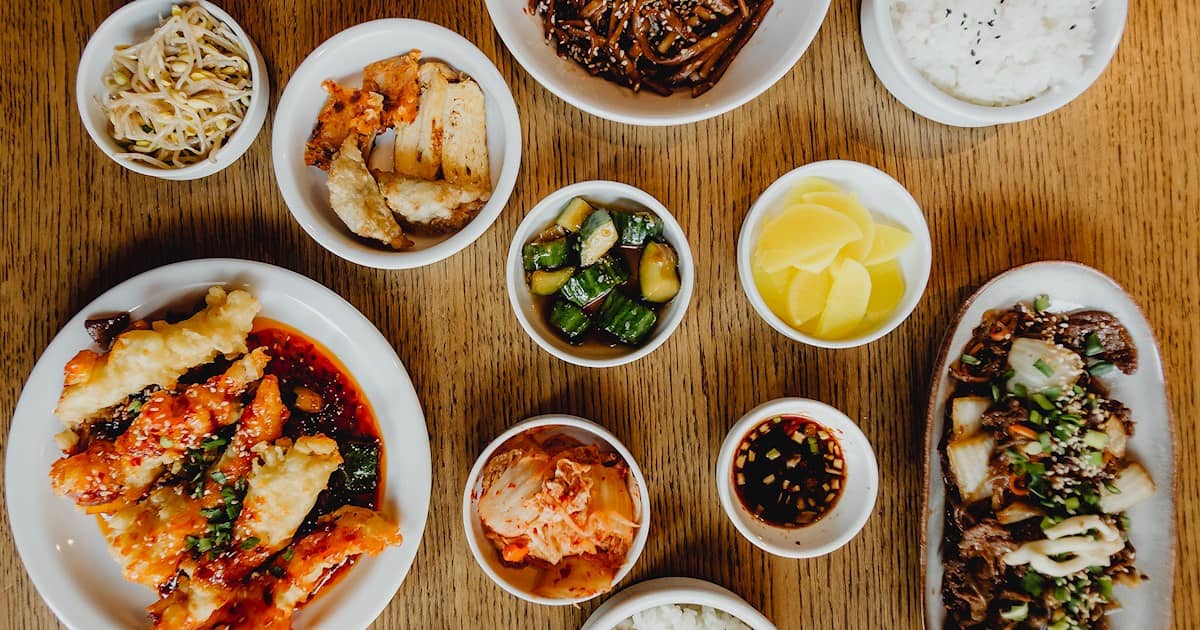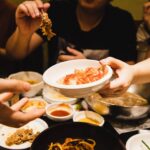Check Out Amazons Huge Range Of Korean Kitchenware

Korean Banchan Essentials
If you’ve ever dined at a Korean restaurant, you’ll notice that the table is adorned with an array of small plates. These dishes are banchan, traditional side dishes that accompany a Korean meal. Banchan is a crucial part of Korean cuisine, and it plays a vital role in creating a balance of flavors and textures in any given meal. In this article, we’ll explore the history of banchan, the different types of banchan dishes available, and the essential ingredients and seasonings required to make these dishes a staple on your dinner table.
Understanding Banchan: A Brief History
Banchan has a long and rich history that dates back to the Joseon Dynasty in the fifteenth century. During this time, a variety of small dishes were served to the royal family, and it was believed that the more dishes there were, the more prosperous the household was. Over time, banchan evolved into what it is today: a way to create balance and harmony in a Korean meal.
Today, banchan is an integral part of Korean culture, and it is served at every meal, from fancy restaurants to humble home kitchens. The number and variety of banchan dishes served can vary greatly, depending on the occasion and the occasion’s formality.
The Origins of Banchan
The origin of the term banchan is not precisely clear, but some believe that it may come from the Korean word ban, which means “half,” and chan, which means “dish.” This may be because the dishes are usually served in small portions.
Another theory suggests that banchan may have originated from the practice of serving food in small dishes to Buddhist monks. This allowed them to have a variety of flavors and textures in their meals while adhering to their strict dietary restrictions.
The Role of Banchan in Korean Cuisine
The primary purpose of banchan is to create a balance of flavors and textures in a Korean meal. Typically, banchan dishes are divided into three categories: namul (seasoned vegetable dishes), bokkeum (stir-fried delicacies), and jorim (braised and simmered dishes). Jeon (savory pancakes and fritters) and jjigae (hearty stews) are also popular banchan dishes in Korea.
Banchan not only adds variety to a meal but also enhances the overall quality of the meal. Since Korean meals often feature rice as the main starch, banchan provides different flavors and textures to complement the rice. In addition, banchan can be used to balance out the spiciness of a dish or to cleanse the palate between bites.
Banchan is also an important part of Korean hospitality. When guests come over, it is customary to offer a variety of banchan dishes to show respect and generosity. The number and variety of banchan dishes offered can be seen as a reflection of the host’s hospitality and generosity.
The Evolution of Banchan
While banchan has a long history, it has also evolved over time. With the introduction of new ingredients and cooking techniques, banchan dishes have become more diverse and creative. In recent years, there has been a trend towards healthier and more modern banchan dishes that incorporate superfoods and other healthy ingredients.
Despite these changes, banchan remains an essential part of Korean cuisine and culture. It is a testament to the importance of balance, harmony, and hospitality in Korean society.
Types of Banchan
Banchan is an essential part of Korean cuisine, and it refers to a variety of small dishes served with rice and soup. These dishes are meant to be shared and enjoyed together, and they add a burst of flavor and texture to every meal. Let’s take a closer look at some of the most popular types of banchan dishes.
Kimchi: The Quintessential Banchan
No discussion of banchan would be complete without mentioning kimchi. This spicy and pungent fermented vegetable dish is made with napa cabbage, radishes, or cucumbers and seasoned with chili powder, garlic, and fish sauce. Kimchi is essential in Korean cuisine and is served with virtually every meal. It is not only delicious but also has many health benefits. Kimchi is rich in vitamins and minerals and is known for its probiotic properties, which promote good gut health.
Namul: Seasoned Vegetable Dishes
Namul is a type of banchan that consists of seasoned vegetables. These dishes are not only tasty but also very healthy. Popular vegetables used in namul dishes include spinach, bean sprouts, and zucchini. These dishes are usually served cold and marinated in a blend of sesame oil, vinegar, soy sauce, and seasonings. Namul dishes are a great way to incorporate more vegetables into your diet and add variety to your meals.
Bokkeum: Stir-Fried Delicacies
Bokkeum dishes are stir-fried delicacies that typically feature meat, seafood, or vegetables. These dishes are known for their bold flavors and are often spicy. One of the most popular bokkeum dishes is japchae, which is made with sweet potato noodles, beef, and vegetables, including carrots, spinach, and shiitake mushrooms. Another popular bokkeum dish is dak galbi, which is made with spicy marinated chicken and vegetables. Bokkeum dishes are a great choice if you’re looking for something filling and flavorful.
Jorim: Braised and Simmered Dishes
Jorim dishes are made by simmering fish, meat, or vegetables in a seasoned broth. These dishes are known for their rich, savory flavors and tender texture. Galbijjim, a braised short rib dish, is a popular jorim dish. Other jorim dishes include fish cakes, tofu, and eggs. Jorim dishes are a great choice if you’re looking for something comforting and satisfying.
Jeon: Savory Pancakes and Fritters
Jeon dishes are savory pancakes and fritters made with a variety of ingredients. These dishes are often served as an appetizer or snack and are perfect for sharing. One popular jeon dish is kimchijeon, a pancake made with kimchi and flour batter. Other ingredients used in jeon dishes include seafood, scallions, and mung beans. Jeon dishes are a great choice if you’re looking for something crispy and flavorful.
Jjigae: Hearty Stews
Jjigae dishes are hearty stews that typically feature tofu, vegetables, and meat, seafood, or both. These dishes are perfect for cold winter days and are known for their comforting and warming qualities. Kimchi jjigae is a popular dish, and it is made with kimchi, pork, and tofu. Other jjigae dishes include sundubu jjigae, which is made with soft tofu, and doenjang jjigae, which is made with soybean paste. Jjigae dishes are a great choice if you’re looking for something filling and satisfying.
In conclusion, banchan dishes are an essential part of Korean cuisine, and they add a burst of flavor and texture to every meal. Whether you’re looking for something spicy, savory, or comforting, there’s a banchan dish for everyone. So the next time you enjoy a Korean meal, be sure to savor each and every banchan dish on the table.
Essential Ingredients and Seasonings
Gochujang: Korean Red Pepper Paste
Gochujang is a staple condiment in Korean cuisine, and it is crucial in many banchan dishes. It is a spicy and savory fermented red pepper paste that is made with glutinous rice, chili peppers, and soybeans. Gochujang is used to add heat and depth to stews, marinades, and dipping sauces.
One of the unique characteristics of gochujang is its fermentation process, which can take anywhere from a few months to a few years. During this time, the flavors of the ingredients meld together, creating a complex and rich flavor profile. The longer the fermentation process, the deeper and more complex the flavor of the gochujang.
Traditionally, gochujang was made at home by Korean families, but now it is widely available in stores and online. It is an essential ingredient in dishes like bibimbap, tteokbokki, and bulgogi.
Doenjang: Fermented Soybean Paste
Doenjang is another essential ingredient in Korean cuisine, and it is a thick, salty fermented soybean paste. It is made by boiling soybeans, grinding them into a paste, and then fermenting them with a culture called meju. The resulting paste is aged for several months to several years, creating a deep and complex flavor.
Doenjang is used in soups, stews, marinades, and dipping sauces and adds depth and umami to any dish it is used in. It is also a source of protein and other nutrients, making it a healthy addition to any meal.
There are many different types of doenjang, each with its own unique flavor profile. Some are made with different types of grains, like barley or rice, while others are made with different types of soybeans. The type of doenjang used in a dish can greatly impact its flavor.
Ganjang: Korean Soy Sauce
Ganjang, or Korean soy sauce, is similar to Japanese soy sauce, but it has a slightly sweeter and milder taste. It is made by fermenting soybeans, wheat, and salt together, creating a rich and savory flavor.
Ganjang is used in marinades and dipping sauces and is a crucial ingredient in kimchi. It is also used as a seasoning for soups and stews, adding depth and umami to the dish.
Like doenjang, there are many different types of ganjang, each with its own unique flavor profile. Some are aged for longer periods of time, creating a deeper and more complex flavor, while others are made with different types of grains, like barley or rice.
Sesame Oil and Seeds
Sesame oil is a fragrant, nutty oil used in a variety of Asian cuisines, including Korean cuisine. It is made by toasting and pressing sesame seeds, creating a rich and flavorful oil.
Sesame oil is used to add flavor to namul dishes, marinades, and dipping sauces. It is also used as a finishing oil, drizzled over dishes like bibimbap or japchae for added flavor and aroma.
Sesame seeds are also used as a garnish in many Korean dishes and add a crunchy texture to banchan dishes. They can be toasted and sprinkled over dishes like gimbap or used as a topping for soups and stews.
Garlic, Ginger, and Green Onions
Garlic, ginger, and green onions are essential aromatics in Korean cuisine and add flavor, depth, and freshness to banchan dishes. They are used in marinades, stews, and stir-fries and are also used as a garnish.
Garlic is used in many Korean dishes, adding a pungent and savory flavor. It is often minced or sliced thinly and added to marinades or stir-fries.
Ginger is used in marinades and stews, adding a spicy and slightly sweet flavor. It is often grated or sliced thinly and added to dishes like galbi jjim or samgyetang.
Green onions are used as a garnish in many Korean dishes, adding a fresh and slightly sweet flavor. They can also be used in marinades and stir-fries, adding a subtle onion flavor.
By incorporating banchan into your meals, you can bring a taste of Korea into your home. With an understanding of the types of banchan dishes available and the essential ingredients and seasonings required to make them, you can create a variety of balanced, flavorful dishes.



